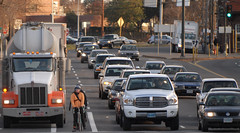[Publisher’s note: This article was written by transportation activist Alexis Grant and it was originally published on the Active Right of Way blog.]
At the annual Transportation Safety Summit on Tuesday, February 6, 2011, at Marshall High School, Mayor Adams started off the summit by asking “Why is safety our highest priority?” It may be a bit heretical of me, but the first question that came to my mind was “Is it? Really?”
What does it mean for safety to be our highest priority on the roads? Vision Zero argues that optimal safety means no loss of life:
No loss of life is acceptable. The Vision Zero approach has proven highly successful. It is based on the simple fact that we are human and make mistakes. The road system needs to keep us moving. But it must also be designed to protect us at every turn.
[For more on Vision Zero, read a Q & A we published back in October with noted traffic safety researcher and proponent of the concept, Peter Jacobsen.]
Are we anywhere near that point? We’re starting to speak that way at times: Mayor Adams said during his portion of the presentation that pedestrian fatalities “should be zero”. Portland Police Bureau Traffic Division Captain Todd Wyatt joined him, saying 26 fatalities among people walking is “still 26 too many”. Jason Tell, ODOT’s Region 1 Manager, said “It’s really about the people” Tom Miller, incoming PBOT director, said “The endgame as far as I’m concerned… is true choice for all of you… Today we have motor vehicle pretty well covered right? But we’ve got a lot more work to do for those traveling on foot, by bike, or those taking transit.”
“… safety is not currently the #1 priority of Portland’s road network. Movement is. Until we decide to change that at a systematic level, there won’t be “true choice” on Portland’s roads, for anyone, including the people getting behind the wheel of a car.”
But in practice, we’re far away from Vision Zero, both in tone and in numbers. There’s still an immense focus on personal responsibility by vulnerable road users: Mr. Tell said “Be visible”. Captain Wyatt spoke about how people riding should wear helmets, and blamed most crashes with walkers on the people walking.
And the streets are still not safe. In the U.S. in 2008, almost 4,400 people were killed and 69,000 injured while walking. Right here in Portland, on 82nd Avenue (one of ten high-crash corridors identified in a recent study), detailed investigation showed there was a crash more than once a day from 1997 to 2006. Forty-five percent of those crashes involved injuries or death (See PDF of 82nd Avenue High Crash Corridor Report).

Tualatin Valley Hwy just feet from where
Bret Lewis was killed last week.
The measures suggested to improve the situation on 82nd included measures as lackluster as “Consider conducting a vehicle speed study.” “Increase enforcement at specific focus areas as staffing allows.” Funding is available for “Develop a letter campaign targeting businesses/property owners to maintain sidewalks, plants, etc.” but not for installing 2038 ft (about 0.4 mi) of sidewalks that would help pedestrians walk safely away from vehicle traffic.
Is safety our #1 priority? As long as we’re looking at a system whose responses to injury and death are “Consider” and “if funding allows”, I don’t think we can say that truthfully. Safety is an afterthought in a system designed “to achieve the efficient, free, and rapid flow of traffic”. When did the Institute of Transportation Engineers (ITE) lose their devotion to the second half of their mission: “Yet, at the same time, to prevent traffic accidents and casualties”?

before PBOT installed a bike box.
And what’s the difference between the ITE mission and Vision Zero’s mission? Not a lot, on the surface; but both the order and the language are telling. Vision Zero starts by saying that no loss of life is acceptable, then acknowledges that the purpose of a transportation system is to enable our movement and says that the way to do this safely is to place the responsibility of protecting users on the system, acknowledging that human error is inevitable.
In contrast, the ITE mission speaks of rapid traffic flow first, and preventing casualties and “accidents” later. They don’t focus on the fact that errors are inevitable, but somehow believe that they can be eliminated. And American traffic engineers follow that order. They focus on optimizing traffic flow and measure their success in vehicle throughput and ‘Level of Service’. We don’t have a corresponding focus on measuring and optimizing safety, so we don’t have corresponding levels of safety. Instead, we examine the system after the fact to see where the safety is notably lacking, and try to fix things up. People die and are injured to show the rest of us that there are serious safety issues with our road system.
After-the-fact safety data collection clearly allows the city to take much-needed measures to improve safety. I’m as glad as anyone when a crossing that scares me gets a new treatment, a road is restriped to provide a bike lane, or a pothole I could break a wheel on is filled. (Confidential to Mayor Adams: smooth streets are safer streets.)
Some might say we have to start where we are. I’d agree. Let’s do that by acknowledging that safety is not currently the #1 priority of Portland’s road network. Movement is. Until we decide to change that at a systematic level, there won’t be “true choice” on Portland’s roads, for anyone, including the people getting behind the wheel of a car.
As Captain Wyatt said, no one gets in their car intending to kill someone — but our road network is designed so that a moment’s inattention makes that possible. Sweden’s Vision Zero is leading the way out of that. Are we ready to follow?


